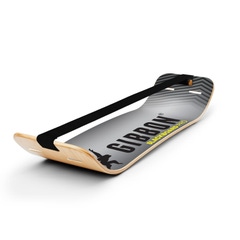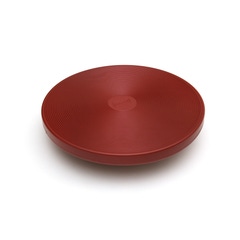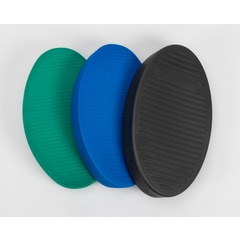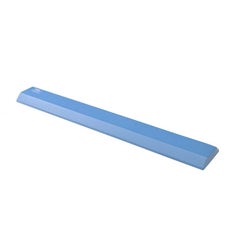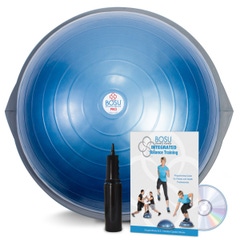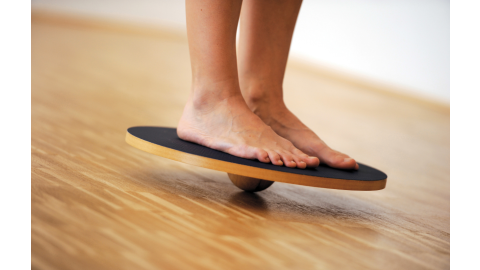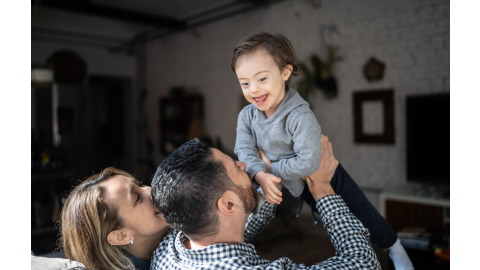Balance training has become one of the most valuable services you can offer in your physical therapy clinic. Whether you're treating post-surgical patients, working with athletes, or helping older adults prevent falls, a dedicated balance training corner creates opportunities for better outcomes and more engaging therapy sessions.
Setting up the right balance training area doesn't have to be complicated or expensive. With the right mix of equipment, you can address virtually every balance challenge your patients face while creating a space that keeps them motivated and progressing toward their goals.
Why Balance Training Matters for Your Patients
As a clinician, you manage balance across the lifespan. Older adults face increased fall risk as proprioception and muscle strength decline. Athletes require dynamic balance to cut, land, and change direction safely. Post-surgical patients need to rebuild confidence and stability. Neurological patients retrain balance systems after stroke, brain injury, or vestibular disorders.
Key fall risk statistics:
CDC: About 1 in 4 adults aged 65+ falls each year; one in five falls causes a serious injury; roughly 3 million emergency department visits and over 800,000 hospitalizations annually; medical costs exceed $50 billion in the U.S. each year.
APTA: Over one-third of adults 65+ fall annually, and 20–30% experience moderate to severe injury.
Balance challenges are not limited to older adults. Evidence-based balance and neuromuscular training help reduce lower-extremity injury risk and support a safe return to sport. Children and teens in sports, adults with chronic ankle instability, workers navigating uneven terrain, and patients with vestibular conditions also gain from improved stability and coordination.
The good news is that balance is trainable at any age. Progressive balance work strengthens proprioception, engages core and hip stabilizers, and sharpens reaction time. This supports rehabilitation after injury or surgery, helps prevent future injuries, and enhances overall functional performance from confident daily gait in older adults to efficient cutting and landing mechanics in sport.
Your balance training corner becomes a place where patients see tangible progress. They feel steadier, stronger, and more confident with each session. This visible improvement supports adherence in the clinic and at home.
Essential Equipment for Your Balance Training Corner
Creating an effective balance training area requires careful selection of equipment that offers variety, progression, and versatility. Here are the key pieces that will give you the most therapeutic value for your investment.
Gibbon Slackboard Pro
The Gibbon Slackboard Pro brings dynamic balance training indoors with a unique slackline experience. This innovative tool challenges your patients' proprioception, core strength, and dynamic balance in ways traditional equipment cannot match.
What makes the Slackboard Pro special is its ability to move in multiple directions simultaneously. Patients must constantly adjust their position, engaging deep stabilizing muscles and improving their reaction time. The webbing surface adds an element of instability that closely mimics real-world balance challenges.
Use the Slackboard Pro for athletes working on sport-specific balance skills, younger patients who need engaging challenges, and anyone looking to improve dynamic stability. Start patients with supported standing and progress to single-leg balance, walking, or even sport-specific movements.
SISSEL® BalanceFit Pad
The SISSEL® BalanceFit Pad provides an unstable foam surface that challenges both static and dynamic balance. Its high-quality foam construction offers the right amount of give to destabilize patients without too much.
This pad works exceptionally well for proprioceptive training. When patients stand on the unstable surface, their nervous system must work harder to maintain balance, strengthening the connection between their brain and muscles. The pad's compact size makes it perfect for home exercise programs too.
Use the BalanceFit Pad for elderly patients working on fall prevention, post-surgical patients rebuilding confidence, and anyone needing to improve their proprioceptive awareness. Progress from bilateral stance to single-leg balance, eyes closed challenges, and dynamic movements.
SISSEL® Balance Board
The SISSEL® Balance Board offers controlled instability with its rocker design. Unlike foam surfaces, the balance board provides predictable movement patterns that help patients understand and master specific balance reactions.
The board's design allows for anterior-posterior and medial-lateral challenges, making it ideal for addressing specific balance deficits. Patients can work on weight shifting, balance reactions, and controlled movements while feeling secure on the stable platform surface.
This equipment works well for patients with ankle instability, those recovering from lower extremity injuries, and anyone needing to improve their balance reactions. Start with supported standing and progress to unsupported balance, single-leg challenges, and functional movements.
THERABAND Stability Trainers
THERABAND Stability Trainers offer versatility with their inflatable design and multiple firmness levels. You can adjust the challenge level by changing the air pressure, making these trainers perfect for patients at any stage of recovery.
The trainers' round shape creates multi-directional instability, challenging patients to maintain balance while their nervous system adapts to the unstable surface. The ability to adjust firmness means you can progress patients gradually without needing different pieces of equipment.
These trainers work well for core strengthening, proprioceptive training, and functional balance activities. Use them for sitting balance exercises, standing challenges, and even upper extremity strengthening with balance components.
Balance Beam
The Balance Beam provides a narrow walking surface that challenges dynamic balance and coordination. Its portable design and varying height options make it adaptable for different patient populations and treatment goals.
Walking on a balance beam requires precise foot placement, weight shifting, and continuous balance corrections. This type of challenge closely mimics real-world activities like walking on uneven surfaces or navigating tight spaces.
Use the balance beam for gait training, dynamic balance challenges, and confidence building. Progress patients from side support to independent walking, backward walking, and carrying objects while walking.
BOSU Pro Balance Trainer
The BOSU Pro Balance Trainer represents the gold standard in versatile balance training equipment. With its dome-on-platform design, it offers two different training surfaces and countless exercise possibilities.
Using the dome side up provides an unstable surface for standing, squatting, and dynamic movements. Flip it over to the platform side, and you have a different type of instability perfect for upper extremity exercises, core training, and advanced balance challenges.
The BOSU Pro works for every patient population. Older adults can use it for gentle balance training, athletes can perform sport-specific movements, and post-surgical patients can progress from basic standing to complex functional activities.
Setting Up Your Balance Training Corner
Location matters when creating your balance training area. Choose a space with enough room for dynamic movements and clear sight lines for supervision. Ensure adequate lighting and consider placing mirrors nearby so patients can monitor their form and see their progress.
Organize your equipment for easy access and quick transitions between exercises. Store smaller items like balance pads and trainers in accessible bins or shelves. Position larger equipment like the BOSU trainer where it won't interfere with patient flow but remains readily available.
Safety should be your top priority. Ensure you have adequate space around each piece of equipment and consider installing ceiling-mounted or wall-mounted safety systems for patients who need additional support during challenging exercises.
Creating Progressive Treatment Programs
The beauty of having diverse balance training equipment lies in your ability to create truly progressive programs. Start patients with basic challenges on stable surfaces and gradually progress to more demanding exercises on unstable equipment.
Begin with bilateral stance activities on firm surfaces, then progress to foam pads, balance boards, and finally dynamic equipment like the Slackboard Pro or BOSU trainer. Add complexity by incorporating cognitive tasks, visual challenges, or functional movements as patients improve.
Use standardized, objective measures to document progress. Prioritize validated tools with clear cut points, repeat testing under consistent conditions, and interpret scores in the context of your patient’s goals. This supports clinical decision-making, communication with referring providers, and payer documentation.
Documenting Progress: Evidence-Based Balance Tests
Select measures that fit your setting, patient goals, and time constraints. The following tests are frequently used and recommended in APTA resources for fall risk assessment and progress tracking:
- Timed Up and Go (TUG): Time to stand from a chair, walk 3 meters, turn, return, and sit. Scores of 12 seconds or more commonly indicate elevated fall risk in community-dwelling older adults. Document assistive device use.
- Five Times Sit-to-Stand (5xSTS): Time to rise from a chair and sit five times without using arms if safe. Times of 15 seconds or more suggest increased fall risk and reduced lower-extremity strength.
- Single Leg Stance (SLS): Time maintaining single-leg stance (eyes open). Shorter times indicate impaired balance; under 5 seconds has been associated with higher fall risk in older adults. Track bilaterally.
- Functional Reach Test: Maximum forward reach distance without stepping. Distances under 7 inches indicate high fall risk; 7–10 inches indicate moderate risk.
- Berg Balance Scale (BBS): 14 functional tasks scored 0–4 (total 0–56). Scores of 45 or less are linked to increased fall risk and are useful for monitoring change over time.
How to apply these measures:
- Test at evaluation, at set intervals (for example, every 2–4 weeks), and at discharge.
- Standardize setup: footwear, assistive device policy, instructions, and rest periods.
- Document raw scores, cut points, and your clinical interpretation to justify progression.
- Use results to guide exercise selection and communicate goals with patients and referrers.
These tools are appropriate across the continuum—not just geriatrics. Use them with older adults in fall prevention, athletes progressing toward return to sport, post-surgical and orthopedic patients, vestibular populations, and workers who navigate variable environments.
If you’d like support selecting measures, standardizing protocols, or building documentation templates for your teams, contact Therapy Partners Group to get started.
Benefits for Your Clinic
A well-equipped balance training corner enhances your clinic's reputation and treatment capabilities. You can accept referrals for vestibular rehabilitation, fall prevention programs, and sports performance training that other clinics might not be equipped to handle.
Patients often find balance training engaging and motivating. Unlike traditional strengthening exercises, balance activities feel more like challenges or games. This engagement leads to better compliance with treatment programs and higher patient satisfaction scores.
The variety of equipment also helps prevent treatment plateaus. When patients master one piece of equipment, you can seamlessly transition them to new challenges, maintaining their motivation and continued improvement throughout their treatment course.
Your balance training corner becomes a visible demonstration of your clinic's commitment to comprehensive care. Prospective patients and referring physicians can see that you offer more than basic treatments – you provide specialized services that address complex balance and stability issues.
Building an effective balance training corner requires investment in quality equipment, but the returns come through improved patient outcomes, increased referrals, and enhanced treatment capabilities. With the right mix of equipment and a commitment to progressive training principles, your balance corner will become one of your clinic's most valuable assets.
Benefits for Your Clinic
A well-equipped balance training corner enhances your clinic's reputation and treatment capabilities. You can accept referrals for vestibular rehabilitation, fall prevention programs, and sports performance training that other clinics might not be equipped to handle.
Patients often find balance training engaging and motivating. Unlike traditional strengthening exercises, balance activities feel more like challenges or games. This engagement leads to better compliance with treatment programs and higher patient satisfaction scores.
The variety of equipment also helps prevent treatment plateaus. When patients master one piece of equipment, you can seamlessly transition them to new challenges, maintaining their motivation and continued improvement throughout their treatment course.
Your balance training corner becomes a visible demonstration of your clinic's commitment to comprehensive care. Prospective patients and referring physicians can see that you offer more than basic treatments – you provide specialized services that address complex balance and stability issues.
Building an effective balance training corner requires investment in quality equipment, but the returns come through improved patient outcomes, increased referrals, and enhanced treatment capabilities. With the right mix of equipment and a commitment to progressive training principles, your balance corner will become one of your clinic's most valuable assets.
References
- Shubert TE. Evidence-based exercise prescription for balance and falls prevention: a current review of the literature. J Geriatr Phys Ther. 2011;34(3):100-108. doi:10.1519/JPT.0b013e3182191d2f
- Wang-Hsu E. Outcome Measure Toolkit for Geriatric Fall/Balance Assessment. APTA Geriatrics. Revised March 2021. Accessed October 29, 2025. https://aptageriatrics.org/wp-content/uploads/2022/02/Balance-and-Falls-Outcome-Measure-Toolkit.pdf
- American Physical Therapy Association. Balance and Falls. Published March 19, 2025. Accessed October 29, 2025. https://www.apta.org/patient-care/public-health-population-care/balance-and-falls
- McMillin A. Top 5 Balance Tests Physical Therapists Use to Prevent Falls in Seniors. Custom Care Rehab. Published June 24, 2025. Accessed October 29, 2025. https://customcarerehab.com/blog/balance-testing
Medical Disclaimer: The information provided on this site, including text, graphics, images, and other material are for informational purposes only and are not intended to substitute for professional medical advice, diagnosis, or treatment. Always seek the advice of your physician or other healthcare professional with any questions or concerns you may have regarding your condition.








 France
France Australia
Australia
